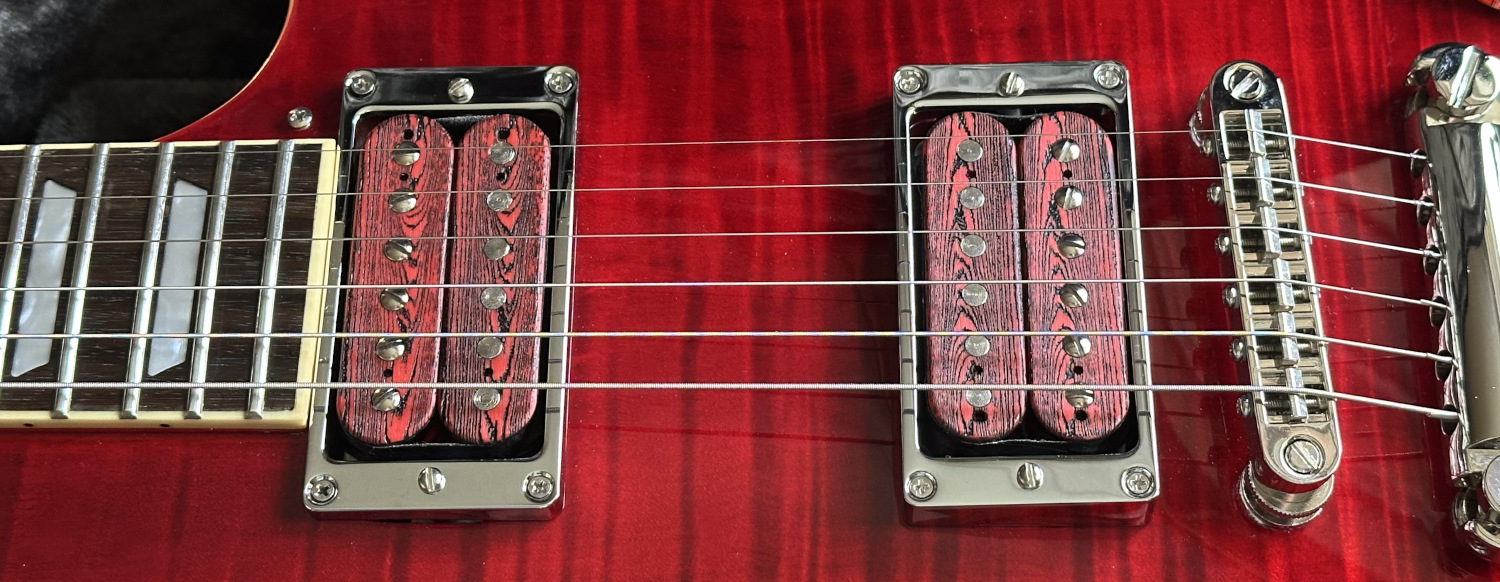Support – Pickups FAQ’s

Support / Guitar Pickups FAQ’s
Please find a few helpful guitar pickup general questions below.
Q: What is the correct height for a pickup?
A: Its really a bit of a preference thing. When a pickup is to close to the strings it tends to produce a muddy sound and lacks clarity. If a pickup is to far away from the strings it tends to produce a thin tone and lack character. We recommend 3mm as a good starting point for the distance of your pickups to the strings.
Q: What is Pickup Potting?
A: Pickup Potting is the process of soaking the pickup in melted wax to saturate the components, which will isolate them and reduce movement of the coils and components. This in turn will reduced the likelihood of noise and microphonic feedback or mechanical failure. The wax we use on our pickups is paraffin wax mixed with bees wax.
Q: If I am left-handed do I need to order “Left-handed pickups?
A: The only time you will really need to order left-handed guitar pickups is if you are ordering a pickup with staggered pole pieces on our Telecaster and Stratocaster range.
Q: Which direction do I install my pickups?
A: It generally make no difference which way the lead wires come out of the pickup. The only time orientation comes into play is with staggered pole pickups.
Q: What is the difference between active and passive pickups?
A: Passive pickups use a magnetic source (poles) of energy and relatively large coils of wire to generate their signal. Active pickups use smaller coils of wire and have a pre-amp built into the pickup to boost the signal. The built in pre-amp can also be adjusted to produce different tones. The other advantage is because an active pickup uses small coils, it produces less noise, buzzing and interference.
Q: What’s the difference between neck, middle and bridge position pickups?
A: The difference between neck, middle and bridge position pickups is their output. There is less volume generated from the bridge pickup due to less string movement, because it is the closer to the bridge. Bridge pickups are wound slightly hotter than neck and the middle pickups to compensate for the reduced string movement. This then produces an even output between all three pickups.
Q: What is Coil Splitting?
A: Coil splitting refers to the ability to disable one coil in a humbucker-type pickup. This gives the guitarist an option of getting a single coil-type tone from a humbucker loaded guitar. Humbuckers normally come with either 2 connection wires which are sometimes braided or 4 connection wires. If 4 connection wires are used then this can give you the option of splitting the coils. You will see that there are 2 wires that are connected together, this is joining the coils to create a humbucker, however if the 2 wires are sent to ground via a switch or push n pull pot, then the humbucker becomes a single coil.
Q: What is Coil Tapping?
A: A coil tap involves a single coil pickup which is made with an extra wire coming off it to give you two different levels of output. The full output and a lower ‘tapped’ output. You can use a push-pull pot or a toggle switch to engage the tapped mode. The benefit here is that you can have a ‘full-power’ sound for solos and huge riffs, then flip to tapped mode to reduce the output, distortion and volume for quieter moments when you need to be in the background.
Q: 2 x Conductor Wires or 4 x Conductor Wires?
A: Most humbuckers offer the choice of 2 or 4 conductor wires when purchasing. 2 x conductor wires will allow you to use basic tone, volume, and pickup switching. 4 x conductor wires can do all of that, plus it gives you the options to add coil-splitting, phase-switching and series/parallel switching. So if you are building a vintage style guitar, you may want to go for Braided wires to keep with the vintage thing. If you are wanting pickup options on a modern guitar you will need 4 x conductor wires. (and of course the same applies in reverse, its your completely your choice).
Q: What’s the difference between Flat Pole and Staggered Pole pickups?
A: If you compared a flat pole pickup to a staggered pole pickup wound the exactly same way, you would get a little more presence, a little more bass and a little more overall output from the flat pole pickup. All Telecasters up until around 1956 had flat-poles. Most Telecasters, Jazzmaster, Mustangs and Fender bass guitars have historically had flat-pole pickups.
Q: What is a Single Coil Pickup?
A: Single coils have a clear, twangy sound, and they tend to sound really great through a clean, un-distorted amp setting. Single coils have a drawback to consider. You notice a bit of background buzz which is just part and parcel of the single coil experience. Some guitarists swear by this excess noise, as it creates the vintage sound and some guitarists want to get rid of it. Single coil pickups are great for country, blues, indie and alternative styles.
Q: What is a P90 Pickup?
A: P90’s are a type of single coil pickup, but it’s larger than a Telecaster style pickup and its sound is warmer, thicker, and grittier. It’s a great choice for alternative, punk, country and blues and works great with slide guitar. P90’s can be prone to the same noise issues as single coils.
Q: What is a Humbucker Pickup?
A: The idea behind humbuckers is to use two separate pickup coils, each wound in a different direction, over a central magnet. The hum is cancelled out by the two different coil directions, hence the name ‘hum-bucker’. The overall tone is generally thicker, louder, warmer and fuller than single coils. Humbuckers are great for heavier styles like classic rock, hard rock and metal, and they can add some toughness and raunch to blues too. The softer, smoother tone of humbuckers are great for jazz as well, especially if you use a humbucker in the neck position on a big hollow-body guitar. In some cases, you’ll find single coils and humbuckers in the same guitar. Popular configurations include a humbucker in the bridge position with single coils in the middle and neck spots, humbuckers in the bridge and neck with a single in the middle, or a single coil in the bridge position of a Telecaster with a humbucker in the neck position.
Q: What are the different types of Pickup Magnets?
A: Whether you choose single coil or humbucker, active or passive pickups, the size, type and configuration of magnet/s used all have a big influence on the sound that the pickup produces, as does the type of wire: how thick the wire is, how it’s insulated, how it’s wound around the bobbins, how many turns of wire etc. There are a few magnets that are typically used in most pickups
Alnico II – Associated with the original PAF humbucker, and it’s still used today in a great number of pickups. The tone is relatively soft and clear, often described as sweet, with a slight rounding off of the more brittle treble frequencies. It can sound very musical and mellifluous with a clean tone, and rather ’singing’ with overdrive.
Alnico III – The ‘weakest’ of the magnets used in pickups with a low magnetic pull, which means the strings are less influenced by the pickup’s magnetic pull, and this makes it a popular choice for neck pickups. It’s a little more ‘confident’ in its tone compared to Alnico II, although both exhibit a similar ‘softness.’ Many guitarists like to balance an Alnico III neck pickup against an Alnico II in the bridge.
Alnico V – These usually sound hotter and more ‘edgy’ than their Alnico II and Alnico III. They’re great at more aggressive tones and in situations where you need a little more ‘unity’ in your chords: notes may knit together a little more tightly when you’re chording through heavy distortion with an Alnico V pickup. It’s also a little warmer in the midrange, which makes it great for lead guitar.
Need More Help? / Get in touch
If you like and use our FREE Support Files and would like to show your appreciation, please buy our team a coffee, thank you.
